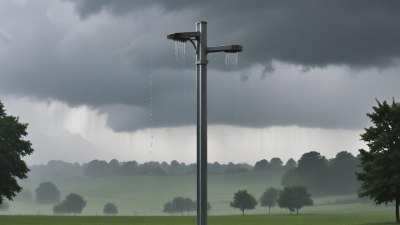How Seasonal Shifts Inspire New Fashion Trends Every Year
Explore how changing seasons influence fashion trends and inspire designers globally.

Image by garetsvisual on Freepik
Fashion is an ever-evolving medium that reflects not only personal style but also broader cultural and environmental shifts. Every year, as the seasons change, the fashion industry responds in innovative and surprising ways. Designers draw inspiration from the world around them, utilizing seasonal changes to propel new trends and styles. This article delves into the connection between seasonal shifts and the evolution of fashion trends, highlighting how these changes affect what we wear.
Understanding the Influence of Seasons on Fashion
The connection between nature and fashion is both profound and historical. Each season brings distinct colors, textures, and moods that inspire designers and consumers alike. Spring, for example, is often characterized by lighter fabrics and brighter colors emerging after the gloom of winter. In contrast, fall invites richer hues and heavier materials as nature prepares for the winter months. This cyclical dynamic creates an annual rhythm that fashion trends tend to follow.
Spring: A Time for Renewal
Spring signifies renewal and growth, encapsulating the essence of rebirth. As trees begin to blossom and flowers bloom, fashion tends to embrace these lively colors. Designers often showcase collections that feature pastels, floral prints, and breathable fabrics, prioritizing comfort and playfulness. The whimsical nature of spring allows designers to experiment with patterns and silhouettes, leading to trends such as off-shoulder tops, midi dresses, and light jackets that can easily be layered.
Moreover, spring is a time where fashion weeks take place around the globe, particularly in cities like New York, Paris, and Milan. These events set the stage for upcoming trends, with high-profile designers debuting their visions for the season. Model runway appearances often dictate what will be popular in retail stores in the coming months, ensuring that the mood of spring is reflected in everyday wear.
Summer: Embracing Ease and Comfort
As the temperatures rise, summer fashion shifts towards a more relaxed and carefree approach. The heat demands lighter fabrics such as cotton, linen, and chiffon that allow for breathability and movement. Summer trends often include vibrant colors and bold prints that resonate with the fun-filled spirit of the season. Swimwear, shorts, sundresses, and sandals dominate summer wardrobes, offering a blend of style and practicality.
In addition to clothing, summer also heralds the return of accessories such as sunglasses, wide-brimmed hats, and light scarves. These items not only serve functional purposes in terms of sun protection but also elevate the overall aesthetic of summer outfits. As festivals and outdoor events ramp up, fashion also adapts to capture the need for festival-ready styles, including bohemian elements, fringe details, and creative layering options.
Fall: A Layering Love Affair
Fall brings with it a sense of nostalgia and warmth, as well as an opportunity for layering. Fashion in this season emphasizes texture and richness, with designers often incorporating materials like wool, suede, and leather into their collections. Colors shift to include deep oranges, burgundies, and browns, reflecting the changing environment. It is during this season that styles like oversized sweaters, tailored coats, and ankle boots gain prominence.
This seasonal change allows for a playful exploration of layering techniques. Fashion enthusiasts can mix and match different lengths and textures, adding dimension to their outfits. Fall also paves the way for the incorporation of bold patterns like plaid or houndstooth, which traditionally evoke feelings of coziness and comfort.
Winter: Embracing Warmth and Elegance
Winter calls for warmth, both in function and in style. As the temperatures drop, fashion trends lean towards luxurious fabrics like cashmere, heavier wool, and faux fur. These materials not only provide insulation but also add an element of sumptuousness to winter wardrobes. Darker shades like navy, forest green, and classic black dominate winter collections, often interspersed with pops of color to keep things vibrant.
Outerwear becomes a focal point during winter, with pieces like long puffer jackets, stylish wool coats, and chic capes becoming essential staples. Accessories such as knitted hats, chunky scarves, and gloves add layers of warmth while allowing for personal style expressions. The winter holiday season also inspires fashion trends, often featuring glittery and sequined elements as people seek to add a touch of glamour to their attire for parties and gatherings.
The Role of Fashion Weeks and Influencers
Fashion weeks are pivotal in shaping trends each season. Designers world over showcase their collections, giving buyers, influencers, and the media a glimpse into what will be trending next. Alongside traditional runway shows, social media influencers and fashion bloggers play an essential role in translating high fashion runway looks into more accessible styles. They bridge the gap between catwalks and street style, ensuring trends influence everyday wear.
In today’s digital age, platforms like Instagram and TikTok have enabled rapid dissemination of trends. A single outfit showcased by a popular influencer can go viral, inspiring countless individuals to replicate the look. This instant cycle makes seasonal trends even more pronounced, as consumers are quick to adapt and embrace new styles showcased online.
The Impact of Sustainability
In recent years, there has been a growing awareness of sustainability in the fashion industry. Seasonal shifts not only influence color, style, and patterns but also the materials used by designers. Contemporary designers are increasingly opting for sustainable fabrics and ethical practices in their collections. This includes using organic cotton, recycled materials, and supporting local artisans.
The trend towards sustainability encourages consumers to make eco-friendly choices and invest in timeless pieces rather than disposable fashions. As consumers become more conscious of their environmental impact, the fashion industry is evolving to meet this demand, leading to new trends that prioritize the planet alongside style.
Cultural Influences That Shape Fashion
Fashion does not exist in a vacuum; it's profoundly influenced by cultural factors, social movements, and global events. Each season’s trends can often reflect current affairs and changing attitudes across society. For instance, during challenging times, simplicity and comfort may emerge as trends, with people opting for cozy loungewear over formal attire.
Globalization further plays a significant role in fashion trends. The exchange of cultural styles has broadened the world of fashion, leading to a blend of global influences in seasonal collections. Designers are embracing elements from different cultures, ensuring that fashion continues to evolve and reflect diverse aesthetics.
The Future of Seasonal Fashion Trends
As we move towards a more fast-paced and digitally connected world, the future of fashion trends will continue to change. Seasonal shifts will remain a key inspiration, but how consumers approach these trends may continue to evolve. With the rise of virtual reality and augmented reality, we may see fashion shows and presentations take on new forms, allowing for immersive experiences that redefine how we engage with fashion.
Moreover, as sustainability and inclusivity gain traction, future fashion trends will likely reflect these values. Fashion could become a more democratic space where personal style is celebrated, embracing all shapes, sizes, and backgrounds. The cyclical nature of fashion will continue, and with each seasonal shift, we will likely witness the birth of fresh trends that resonate with the changing world.
Seasonal shifts undeniably inspire new fashion trends each year. From spring's lightness to winter's warmth, we see a dynamic interplay between nature and style. As the seasons change, so do our wardrobes, reflecting not only the environment but also social and cultural currents. Understanding this connection enhances our appreciation for fashion as a living, breathing entity that adapts with us. In accepting seasonal changes, we celebrate the creativity of designers and the evolving nature of style itself, inspiring us all to embrace each season's unique aesthetic.











